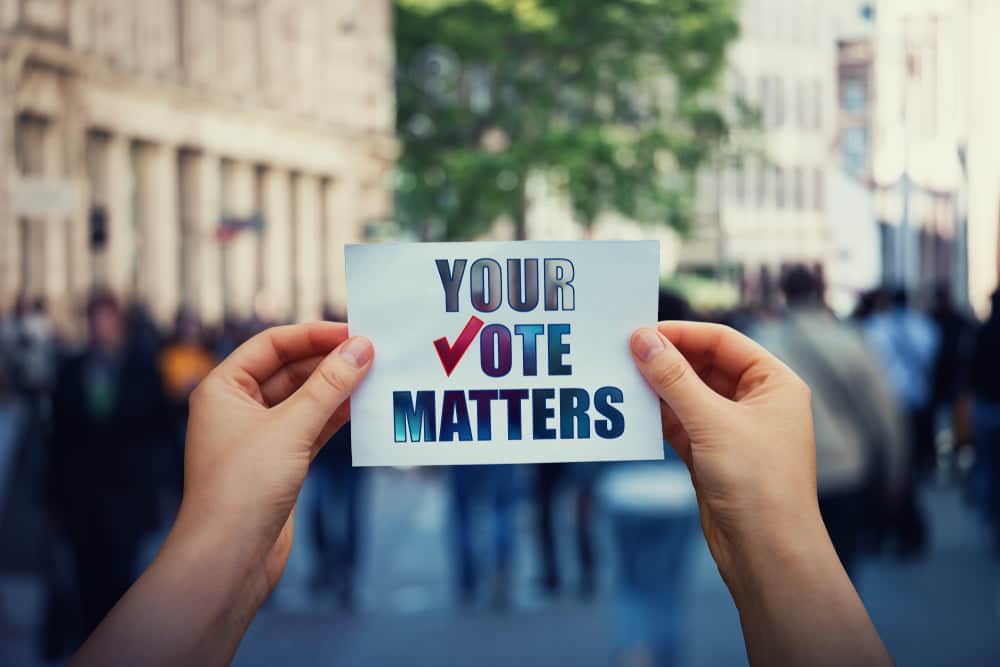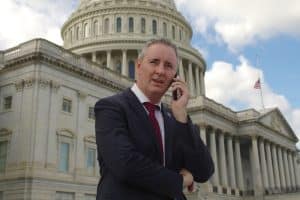Written by Robert Speel, Penn State
Pennsylvania’s role as a swing state in presidential elections is a modern continuation of a characteristic noted as early as 1802. At a rally celebrating the election victory of President Thomas Jefferson, Pennsylvania was reportedly referred to as “the keystone of the federal union” – a keystone being the central stone in an arch that keeps all the other arch stones in place.
Since the nation’s earliest days, Pennsylvania has in many ways been at the center of the action. The state hosted the Continental Congress in Philadelphia in the 1770s and was the final state to make approval of the Declaration of Independence unanimous in July 1776. At the time of independence, Pennsylvania was also at the geographical center of the 13 original Colonies, with six states to its south and six states to its north and east.
The state hasn’t always been a swing state, but it has usually been central to presidential campaigns – and remains so today. Pennsylvania includes voters with a broad range of political views, usually keeping results close in statewide elections.
Philadelphia voters are almost entirely liberal on all issues, while most rural Pennsylvania voters are usually conservative and skeptical of urban politics. The state’s main suburban areas are split, though, with Philadelphia’s supporting Democrats and Pittsburgh’s supporting Republicans.
Meanwhile, the often-overlooked smaller metro areas of Pennsylvania, like Harrisburg, Allentown-Bethlehem, Erie and Scranton, are the true swing areas of the swing state.
Pennsylvania transitions from swing state to solid Republican
As the regional political divide between North and South grew in the 19th century, Pennsylvania’s key role in presidential elections grew as well. Between 1828 and 1880, Pennsylvania was the only state to vote for the winning candidate in every presidential election. Pennsylvania voters vacillated between supporting Democrats and Whigs from the 1830s to the 1850s, and then voted for all of the winning Republican presidential candidates in the 1860s and 1870s.
Pennsylvania was not a swing state for many decades after the Civil War. Voters there supported Republican candidates in every presidential election between 1860 and 1932 – including Progressive Republican Theodore Roosevelt in 1912.
Pennsylvania switches to lean toward Democrats
Through the 1940s, Pennsylvania continued to support Republican presidential candidates more than the rest of the country did as a whole. But then the state switched abruptly and began to support Democratic presidential candidates by margins larger than the nation’s electorate as a whole for 60 years from 1952 through 2012.
That is partly because the power of the Republican political machine in Philadelphia disintegrated. There has been no Republican mayor there since 1952.
INTERVIEW: Katherine Stewart Unpacks Senator Josh Hawley’s Speech – ‘The Christian Nationalism We Need’
When the South began to trend Republican in the 1950s and 1960s, and Philadelphia became more Democratic, the state of Pennsylvania also became more Democratic than the country as a whole in presidential elections. Pennsylvania continued to lack status as a swing state in Electoral College politics, as Democrats won all the close presidential elections there for 60 years, even when Republicans won nationwide. That included 1968, when Democrat Hubert Humphrey won the state; 2000, when Democrat Al Gore won Pennsylvania, but lost a close and disputed national electoral vote; and 2004, when Democrat John Kerry won the Keystone State.
The years when Pennsylvanians voted for a Republican presidential candidate were only those when the Republican won the nation as a whole by particularly large margins – twice for Eisenhower, for Nixon’s reelection, and twice for Reagan.
Pennsylvania returns to swing state status in the 21st Century
However, early this century, in a series of closely contested presidential elections, Republicans began to sense opportunities for Pennsylvania to play a role in national Electoral College calculations.
The proliferation of state political polling meant campaigns could determine state-specific voting trends. Most states were found to reliably vote for one party in every presidential election – spawning the labeling of “blue states” and “red states” that began after the 2000 election. That left only a small number of swing states with close polls to be perceived as crucial for victory.
READ: Legislating Inequality: The Christian Confederate Roots of Project 2025
During the 2000 election campaign, the media repeatedly emphasized that Pennsylvania, Florida and Michigan were the key battleground states, based on polling and on their large share of electoral votes. When Gore was announced the winner of all three states early on election night, everyone assumed that he would therefore become president. However, later that night, the projection that Gore won Florida was retracted, leading to a long legal battle that ended with George W. Bush as president.
Pennsylvania continued to be perceived as a potential victory for Republicans in the next three presidential elections, even though Democrats won each time. The Republican efforts were sometimes criticized as futile in the media and among political consultants.
Pennsylvania flips to Trump and then to Biden
But with Trump in 2016, the Republican Party had a breakthrough in Pennsylvania, not only winning the presidential election there for the first time since George H.W. Bush in 1988, but also performing better there than in nationwide results.
The deciding factors included Trump’s high popularity in the rural parts of the state and in suburban Pittsburgh, and Hillary Clinton’s not making campaign appearances in many cities outside the state’s two major metro areas. Trump’s surprising – though very small – wins in Pennsylvania, Michigan and Wisconsin that year provided the margin of his Electoral College victory and have led to a national media and political focus on those three key swing states ever since.
Biden, who was born in Scranton, won the state back for Democrats in 2020. But Trump still won a higher vote percentage in Pennsylvania than he won nationwide.
In the 2024 rematch of the 2020 election, both campaigns will likely continue to focus a lot of time and resources on the Keystone State as one of the main opportunities for an Electoral College majority in November.
Robert Speel is Associate Professor of Political Science Penn State Erie Campus.
This article is republished from The Conversation under a Creative Commons license. Read the original article.






